Gas Permeability Evolution of Coal with Inclusions under Triaxial Compression-Lab Testing and Numerical Simulations
Abstract
1. Introduction
2. CT Image Reconstruction
3. Permeability Test under Triaxial Compression
4. Fluid-Mechanical Coupled Numerical Simulations
4.1. Numerical Modeling
4.2. Analysis of Numerical Simulations
5. Results and Discussions
5.1. Laboratory Tests
- Initial compaction stage (I). Permeability decreases linearly with increasing axial loading. Internal voids close under compression, so the flow rate decreases due to the shut-down of seepage paths. However, a general permeability decrease is not significant. When the axial differential stress reaches 8.78 MPa, permeability decreases to a minimal level, and the corresponding stress point is defined as σm. It is difficult to observe any gas seepage.
- Linear elastic deformation stage (II). Beyond the stress point σm, permeability increases moderately. The flow rate increases significantly following the stress–strain behavior. In this stage, initial pores grow and new microcracks are generated.
- Nonlinear deformation and peak strength stage (III). With continuous increase of axial stress, cracks become wider and coalesce. Macroscopic fractures begin to appear and permeability increases drastically.
- Strain softening stage (IV). After the peak differential stress (28 MPa), permeability increases continuously with axial strain. Such a scenario lasts until differential stress decreases to 22.74 MPa. Then, permeability and flow rate reach peak values and maintain constant. Fracture apertures increase, fractures coalesce and the fracture network is fully developed.
- Residual stress stage (V). Ongoing deformations cause abrasion on fracture surfaces. The apertures decrease with ongoing decrease of surface roughness. To some extent compaction appears and permeability is decreasing. This decrease is more pronounced at higher confining pressures.
5.2. Numerical Simulations
6. Conclusions
Author Contributions
Funding
Institutional Review Board Statement
Informed Consent Statement
Data Availability Statement
Conflicts of Interest
References
- Karacan, C.Ö.; Mitchell, G.D. Behavior and Effect of Different Coal Microlithotypes during Gas Transport for Carbon Dioxide Sequestration into Coal Seams. Int. J. Coal Geol. 2003, 53, 201–217. [Google Scholar] [CrossRef]
- Yao, Y.-B.; Liu, D.-M. Adsorption Characteristics of Coal Reservoirs in North China and Its Influencing Factors. Zhongguo Kuangye Daxue Xuebao/J. China Univ. Min. Technol. 2007, 36, 308. [Google Scholar]
- Yao, Y.; Liu, D.; Tang, D.; Tang, S.; Huang, W. Fractal Characterization of Adsorption-Pores of Coals from North China: An Investigation on CH4adsorption Capacity of Coals. Int. J. Coal Geol. 2008, 73, 27–42. [Google Scholar] [CrossRef]
- Zuber, M.D. Production Characteristics and Reservoir Analysis of Coalbed Methane Reservoirs. Int. J. Coal Geol. 1998, 38, 27–45. [Google Scholar] [CrossRef]
- Ketcham, R.A.; Carlson, W.D. Acquisition, Optimization and Interpretation of x-Ray Computed Tomographic Imagery: Applications to the Geosciences. Comput. Geosci. 2001, 27, 381–400. [Google Scholar] [CrossRef]
- Cnudde, V.; Boone, M.N. High-Resolution X-Ray Computed Tomography in Geosciences: A Review of the Current Technology and Applications. Earth-Sci. Rev. 2013, 123, 1–17. [Google Scholar] [CrossRef]
- Wolf, K.-H.A.A.; van Bergen, F.; Ephraim, R.; Pagnier, H. Determination of the Cleat Angle Distribution of the RECOPOL Coal Seams, Using CT-Scans and Image Analysis on Drilling Cuttings and Coal Blocks. Int. J. Coal Geol. 2008, 73, 259–272. [Google Scholar] [CrossRef]
- Jing, L.; Hudson, J.A. Numerical Methods in Rock Mechanics. Int. J. Rock Mech. Min. Sci. 2002, 39, 409–427. [Google Scholar] [CrossRef]
- Zhao, Y.; Liu, S.; Zhao, G.-F.; Elsworth, D.; Jiang, Y.; Han, J. Failure Mechanisms in Coal: Dependence on Strain Rate and Microstructure. J. Geophys. Res. Solid Earth Res. 2010, 119, 6924–6935. [Google Scholar] [CrossRef]
- Tan, X.; Konietzky, H. Numerical Study of Variation in Biot’s Coefficient with Respect to Microstructure of Rocks. Tectonophysics 2014, 610, 159–171. [Google Scholar] [CrossRef]
- Cundall, P.A.; Strack, O.D.L. A Discrete Numerical Model for Granular Assemblies. Geotechnique 1979, 29, 47–65. [Google Scholar] [CrossRef]
- Baumgarten, L.; Konietzky, H. Stress-Strain, Strength and Failure Behavior of Postaer Sandstone in Tension and Compression Tests–Laboratory Investigations and Numerical Modelling with PFC3D. In Proceedings of the 41 Geomechanik-Kolloquium, Freiberg, Germany, November 2012; Publ. Geotechnical Institute, TU Bergakademie Freiberg: Freiberg, Germany, 2012; Volume 1, pp. 41–61. [Google Scholar]
- Potyondy, D.O.; Cundall, P.A. A Bonded-Particle Model for Rock. Int. J. Rock Mech. Min. Sci. 2004, 41, 1329–1364. [Google Scholar] [CrossRef]
- Yan, Y.; Ji, S. Discrete Element Modeling of Direct Shear Tests for a Granular Material. Int. J. Numer. Anal. Methods Geomech. 2010, 34, 978–990. [Google Scholar] [CrossRef]
- Yang, Y.; Song, Y.; Chen, S. Test Study on Permeability Properties of Coal Specimen in Complete Stress-Strain Process. Rock Soil Mech. 2007, 28, 381–385. [Google Scholar]
- Tan, X. Hydro-Mechanical Coupled Behavior of Brittle Rocks—Laboratory Experiments and Numerical Simulations; Technischen Universität Bergakademie Freiberg: Freiberg, Germany, 2013. [Google Scholar]
- Li, X.; Wang, Y.; Wei, N. Research on Measuring Method of Permeability by Using Storage-Variable Transient Pulse Method. Chin. J. Rock Mech. Eng. 2008, 27, 2482–2487. [Google Scholar]
- Somerton, W.H.; Soeylemezoglu, I.M.; Dudley, R.C. Effect of Stress on Permeability of Coal. Int. J. Rock Mech. Min. Sci. Geomech. 1975, 12, 129–145. [Google Scholar] [CrossRef]
- Lespinasse, M.; Sausse, J. Quantification of Fluid Flow: Hydro-Mechanical Behaviour of Different Natural Rough Fractures. J. Geochem. Explor. 2000, 69, 484–486. [Google Scholar] [CrossRef]
- Lee, H.S.; Park, Y.J.; Cho, T.F.; You, K.H. Influence of Asperity Degradation on the Mechanical Behavior of Rough Rock Joints under Cyclic Shear Loading. Int. J. Rock Mech. Min. Sci. 2001, 38, 967–980. [Google Scholar] [CrossRef]
- Zhao, Y.; Konietzky, H.; Herbst, M. Damage Evolution of Coal with Inclusions Under Triaxial Compression. Rock Mech. Rock Eng. 2021, 54, 5319–5336. [Google Scholar] [CrossRef]
- Itasca. PFC3D-Particle Flow Code in 3 Dimensions; Verion 3.10-305; Itasca Consulting Group Inc.: Minneapolis, MN, USA, 2008. [Google Scholar]
- Neuman, S.P. Multiscale Relationships between Fracture Length, Aperture, Density and Permeability. Geophys. Res. Lett. 2008, 35, L22402. [Google Scholar] [CrossRef]
- Bonnet, E.; Bour, O.; Odling, N.E.; Davy, P.; Main, I.; Cowie, P.; Berkowitz, B. Scaling of Fracture Systems in Geological Media. Rev. Geophys. 2001, 39, 347–383. [Google Scholar] [CrossRef]
- Witherspoon, P.A.; Wang, J.S.Y.; Iwai, K.; Gale, J.E. Validity of Cubic Law for Fluid Flow in a Deformable Rock Fracture. Water Resour. Res. 1980, 16, 1016–1024. [Google Scholar] [CrossRef]
- Barton, N. The Shear Strength of Rock and Rock Joints. Int. J. Rock Mech. Min. Sci. 1976, 13, 255–279. [Google Scholar] [CrossRef]
- Ki-Bok, M.; Rutqvist, J.; Tsang, C.F.; Jing, L. Stress-Dependent Permeability of Fractured Rock Masses: A Numerical Study. Int. J. Rock Mech. Min. Sci. 2004, 41, 1191–1210. [Google Scholar] [CrossRef]
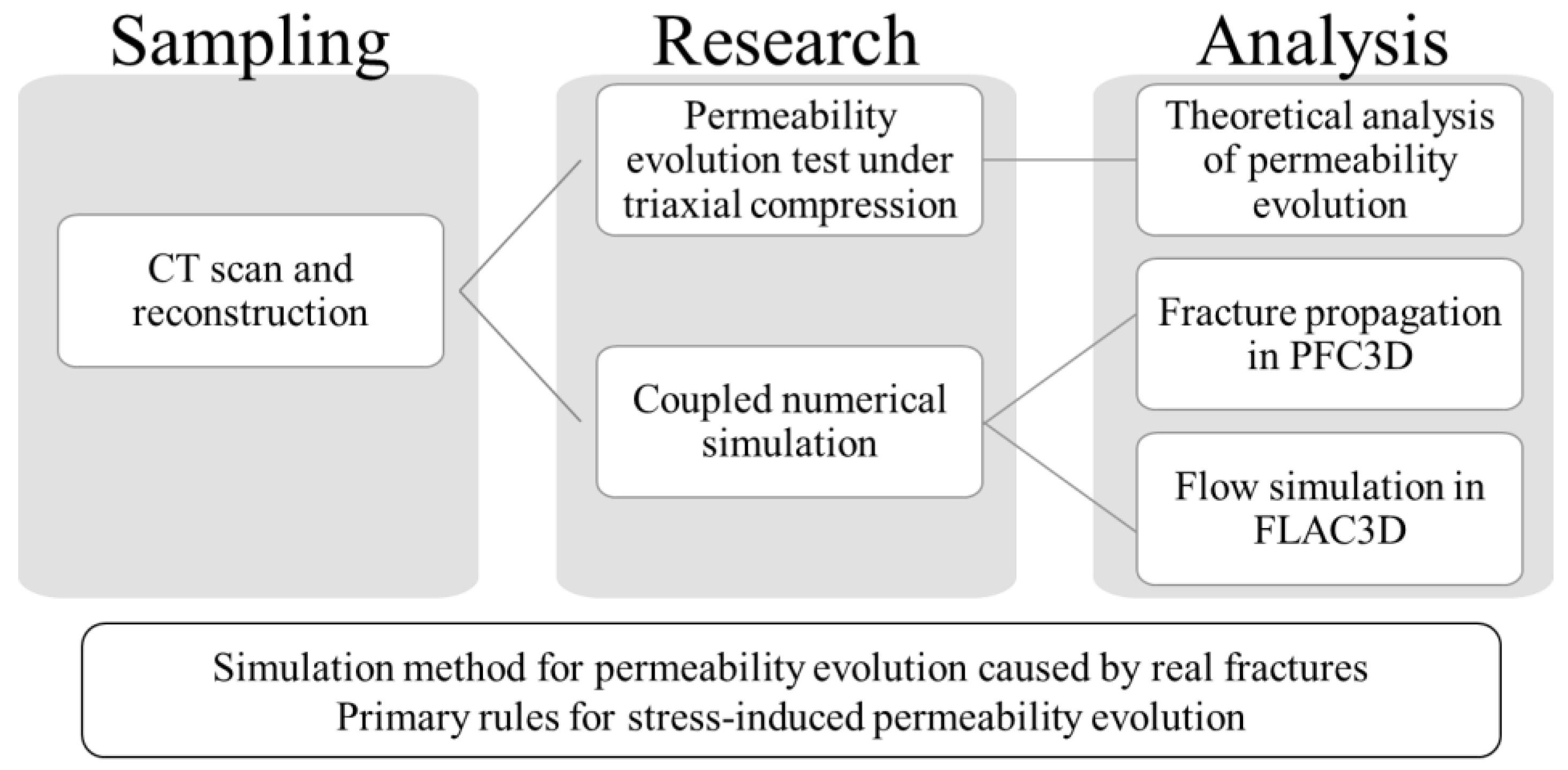

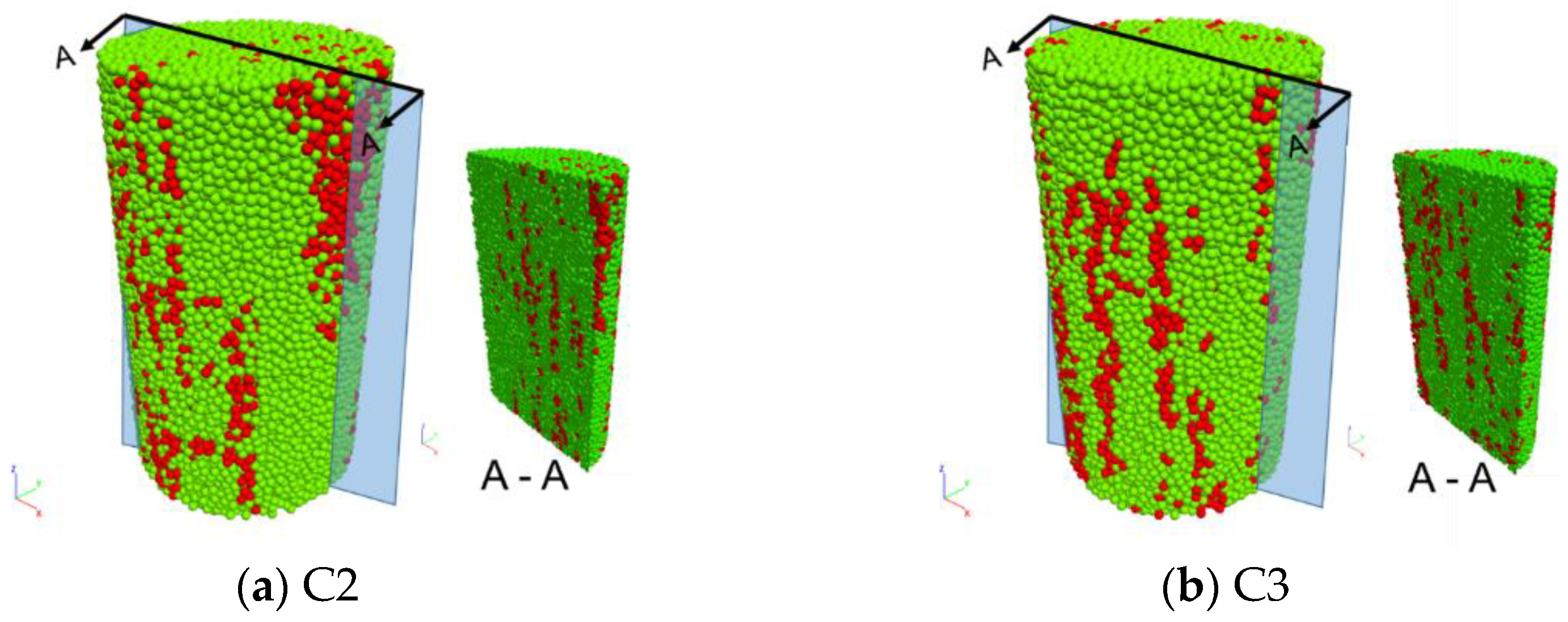
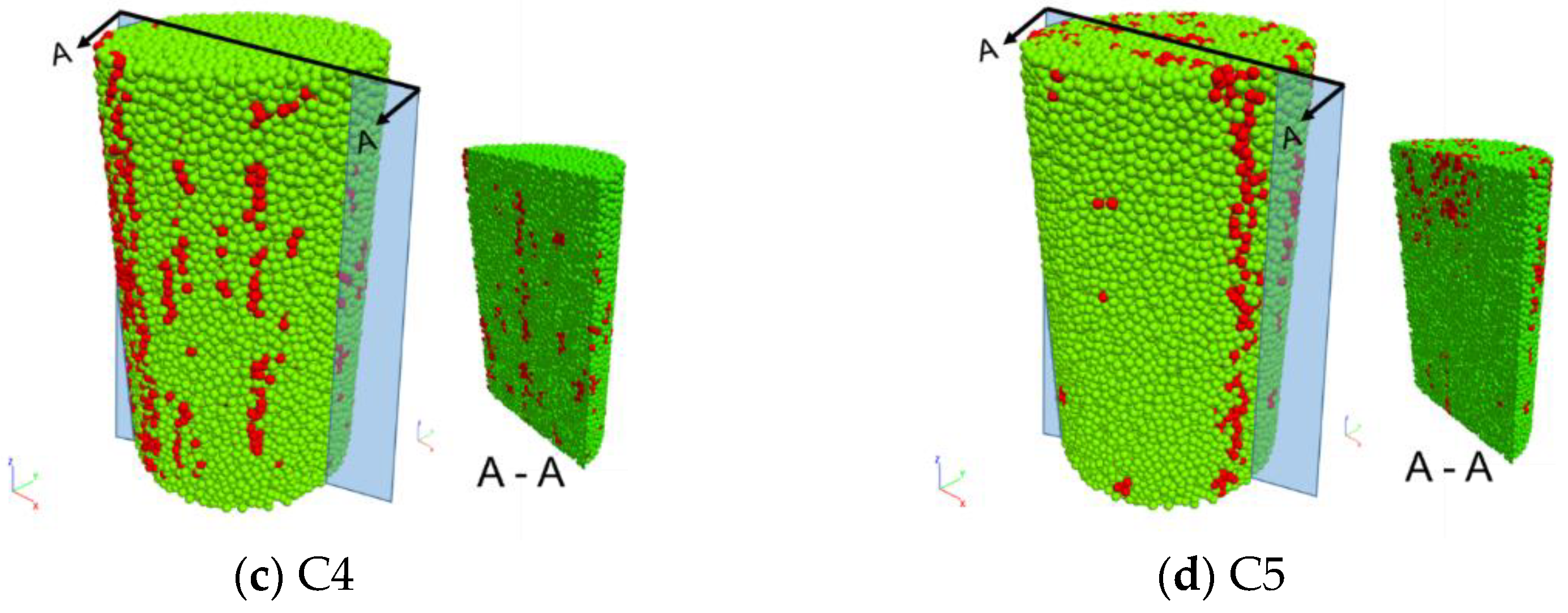



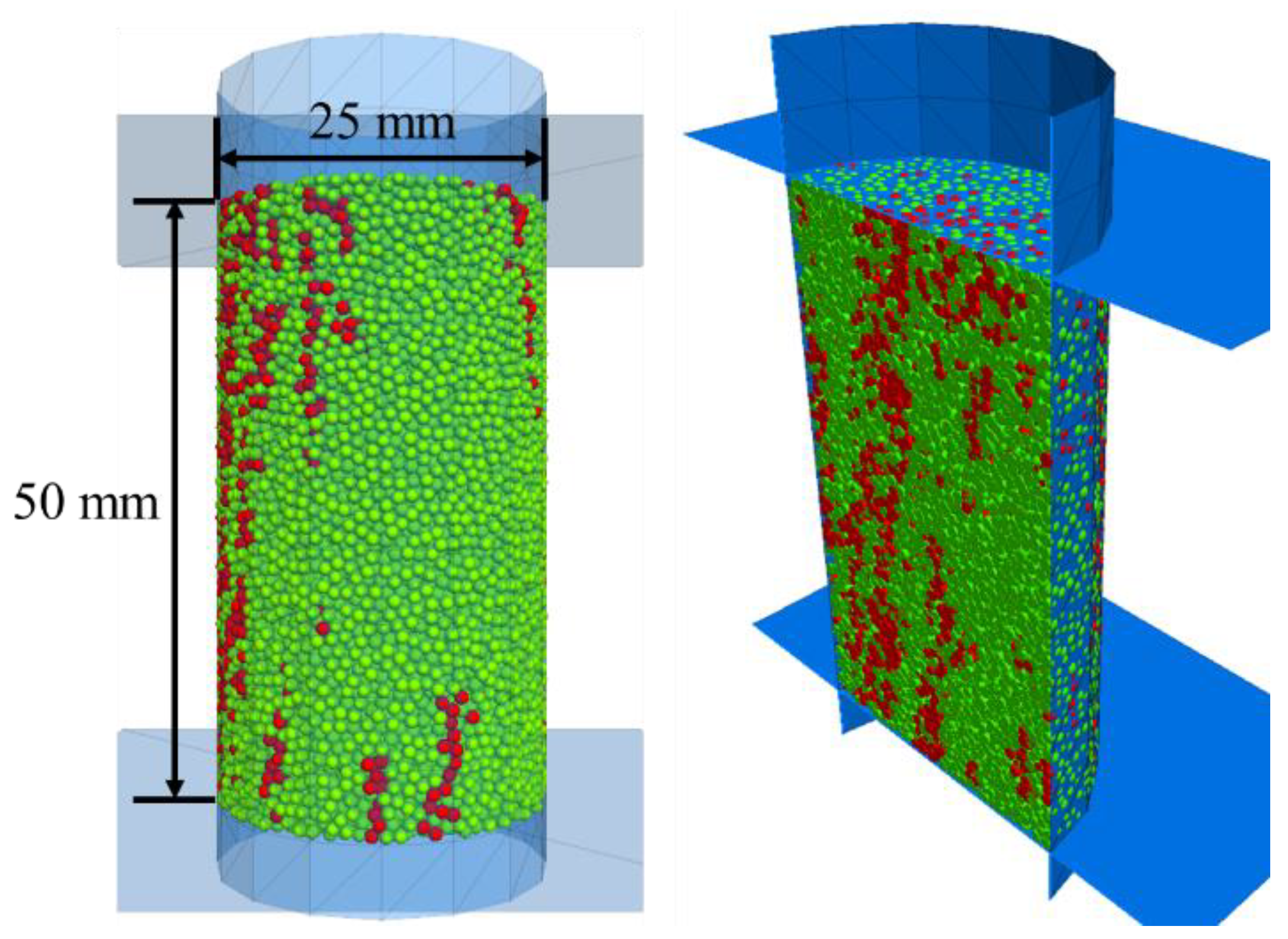
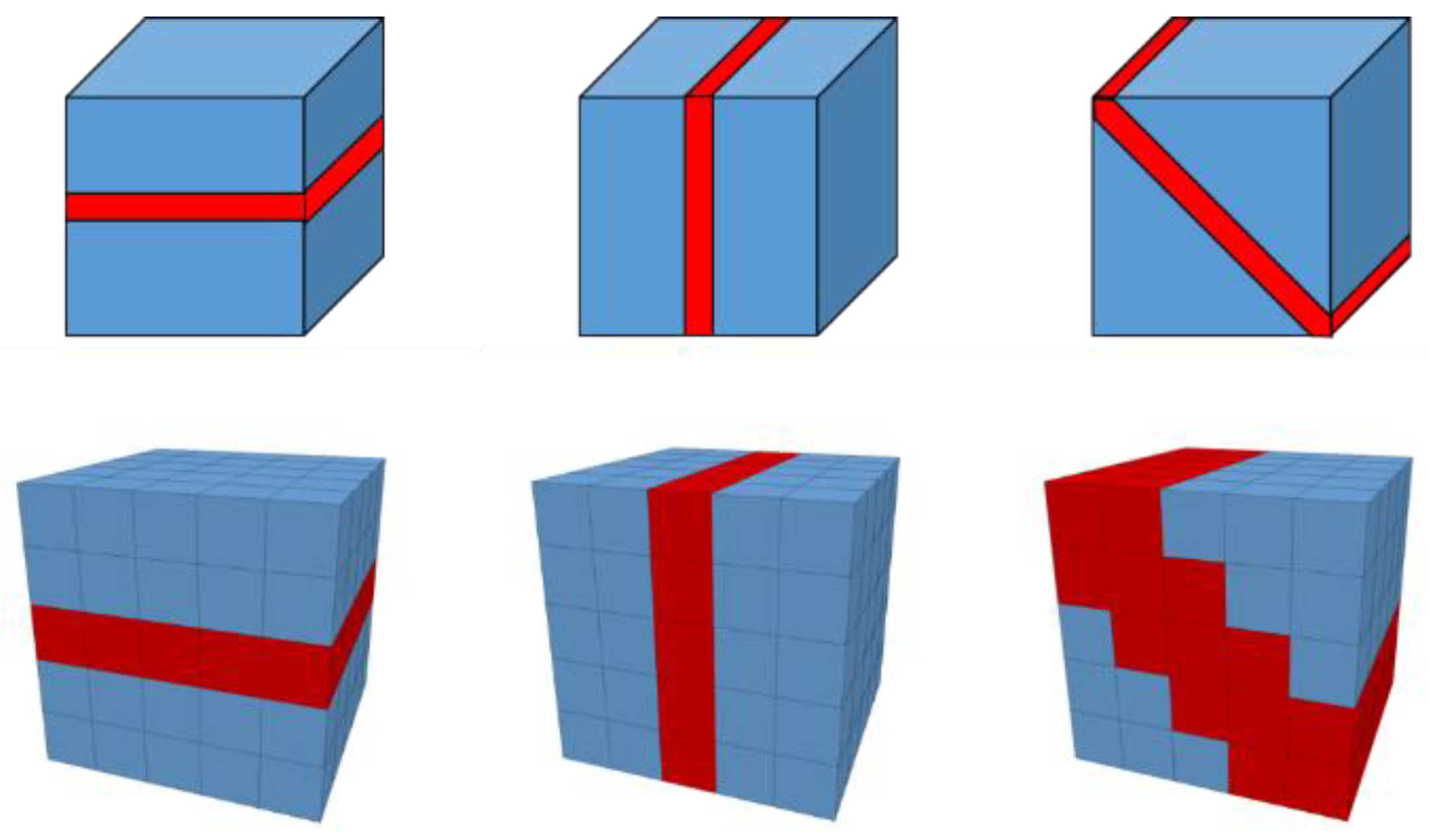

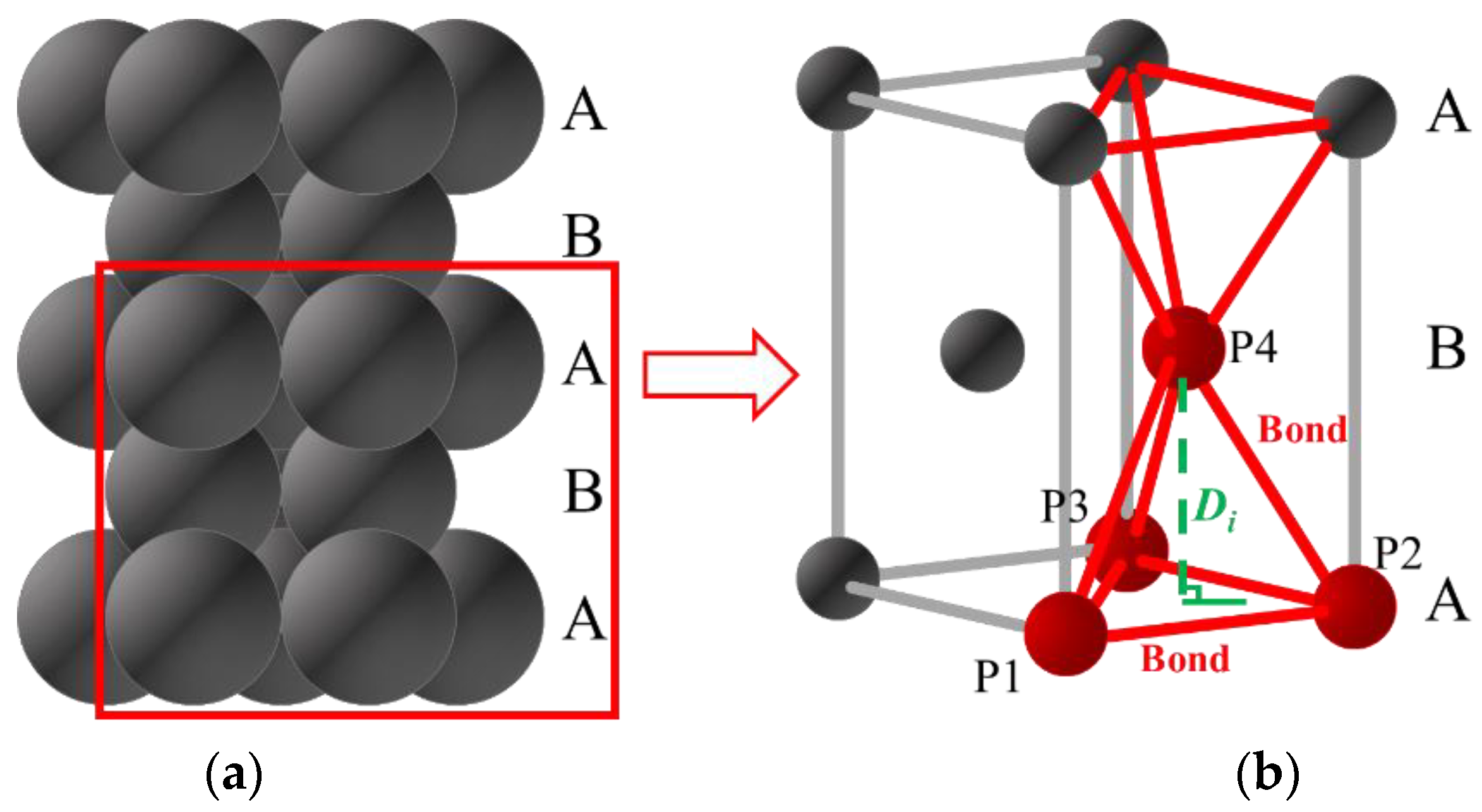
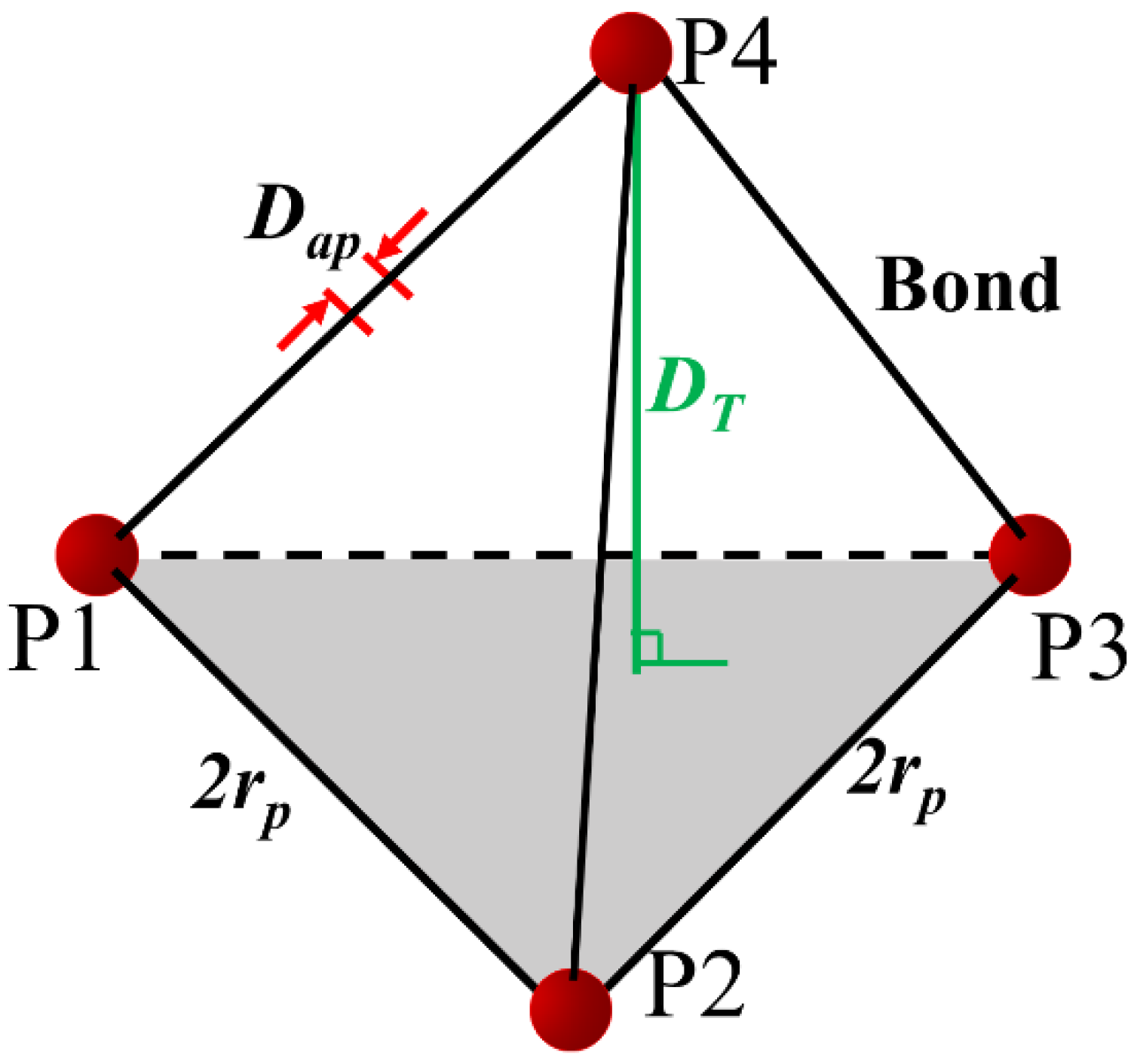
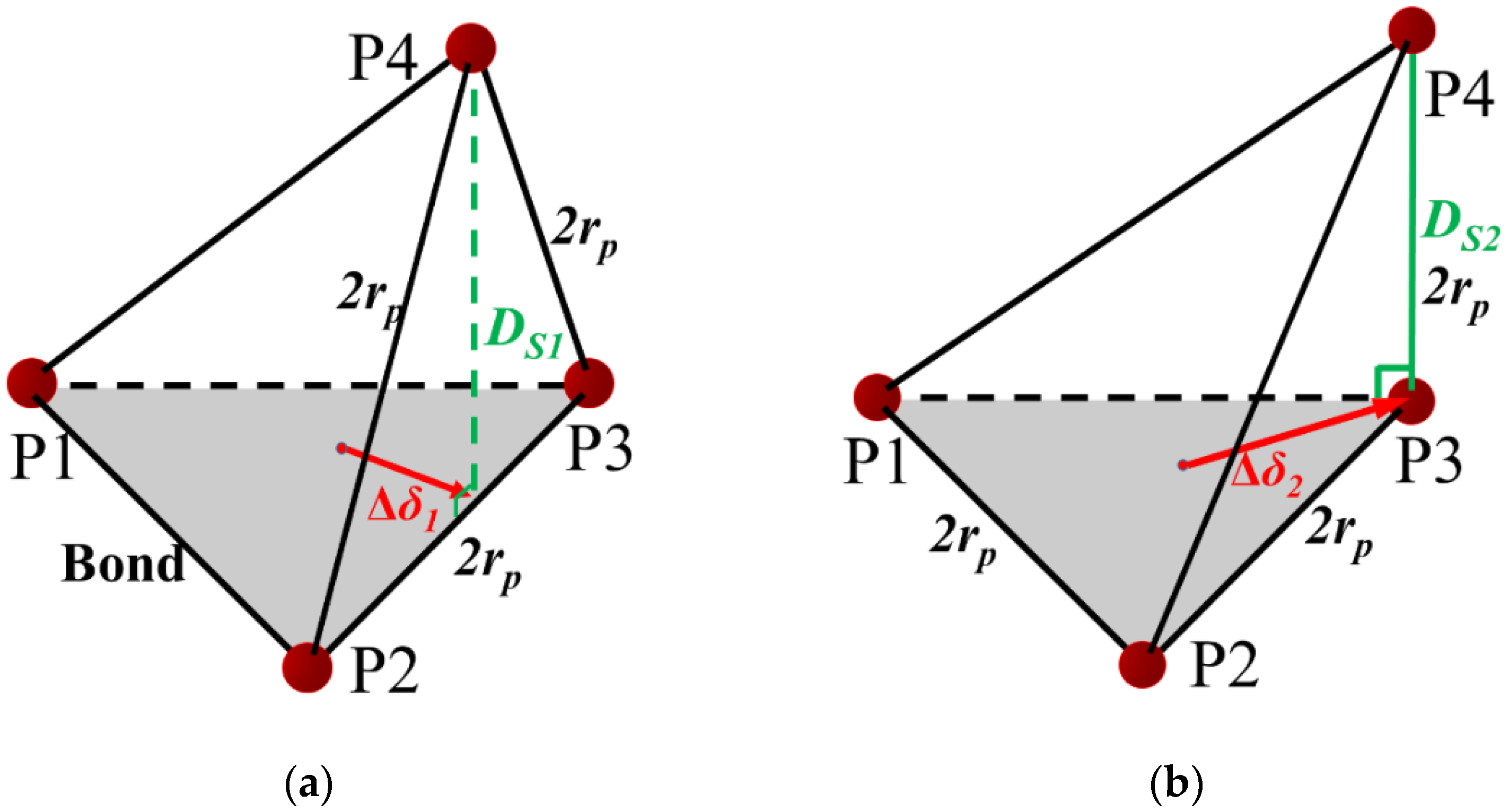
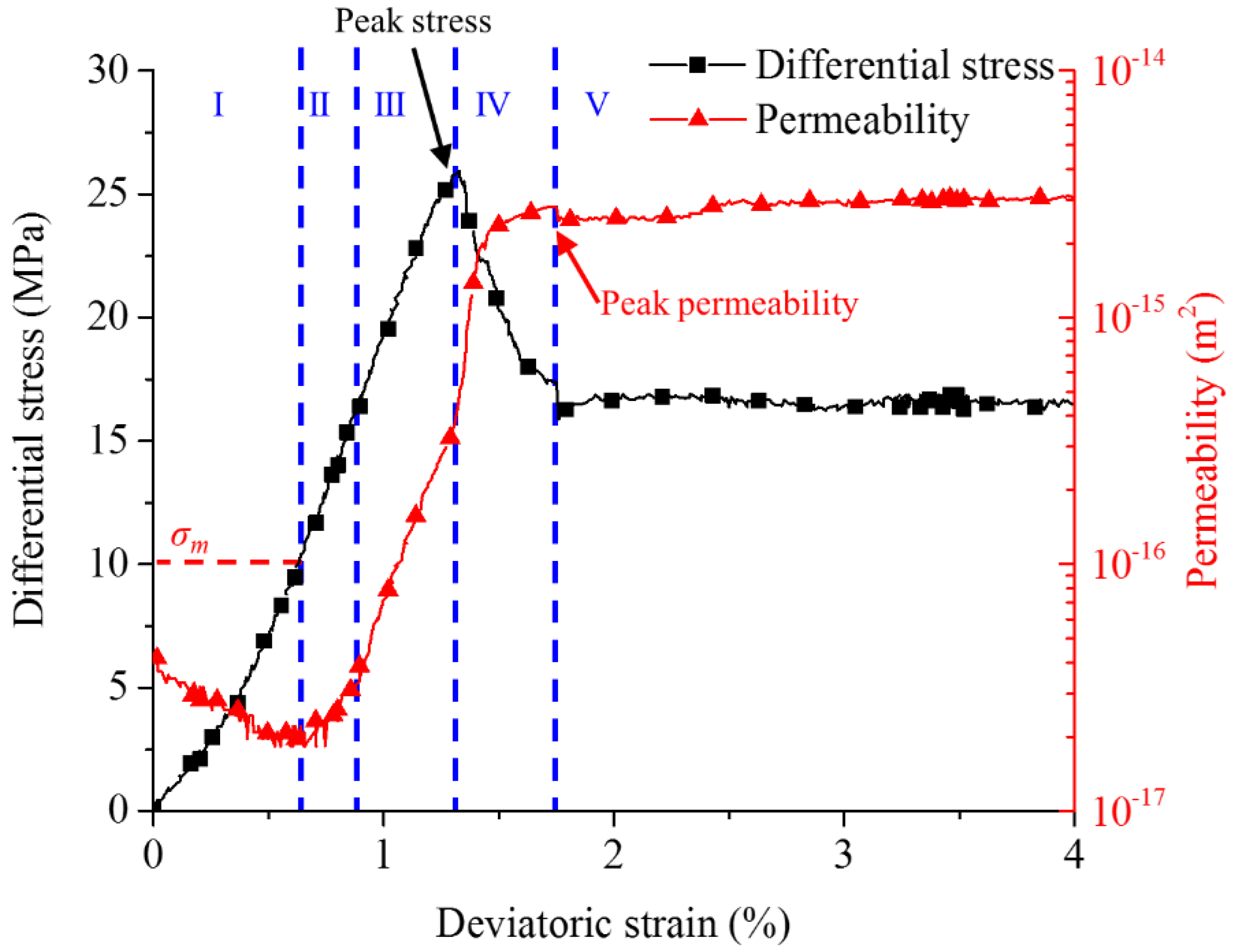

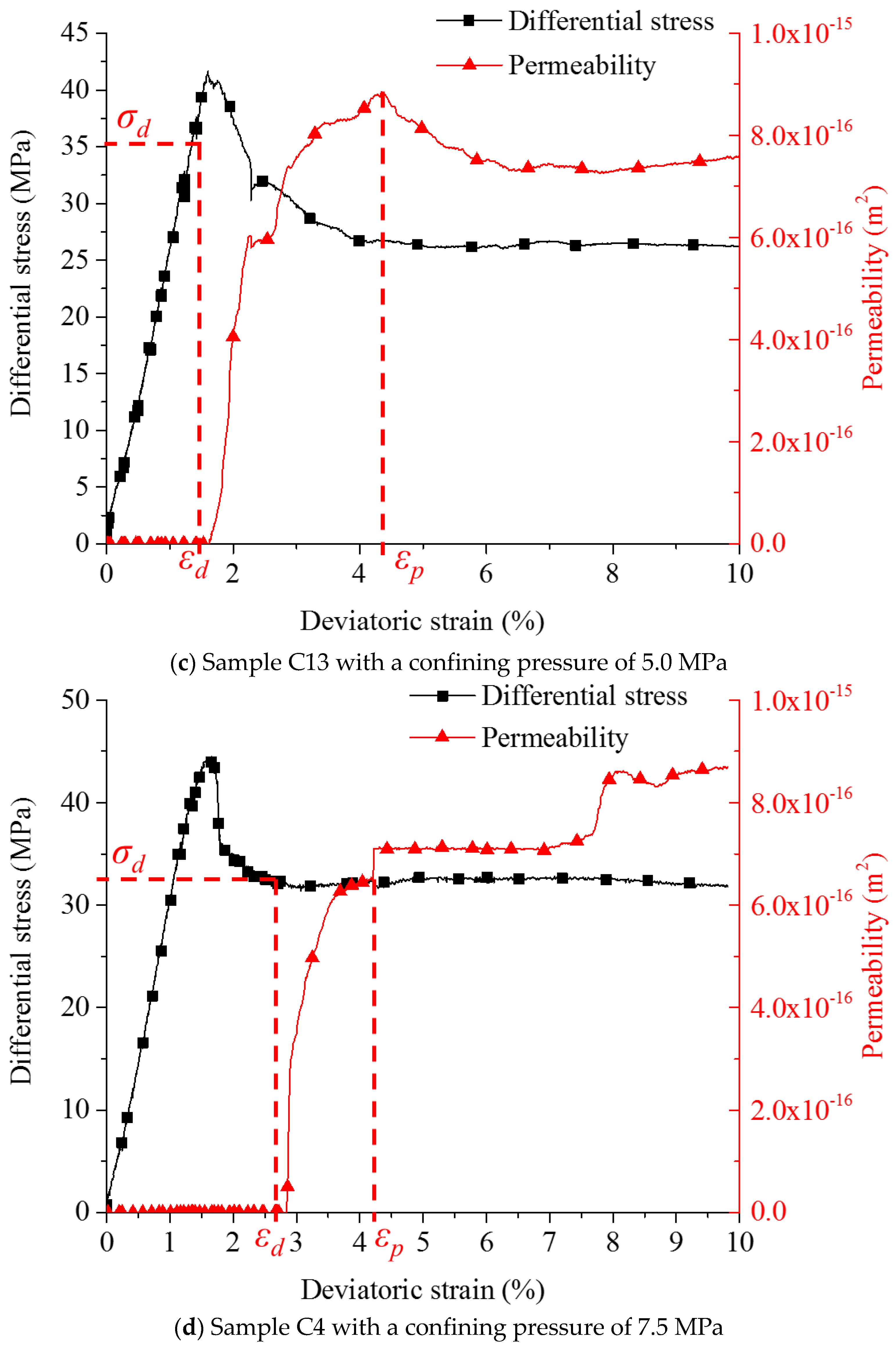
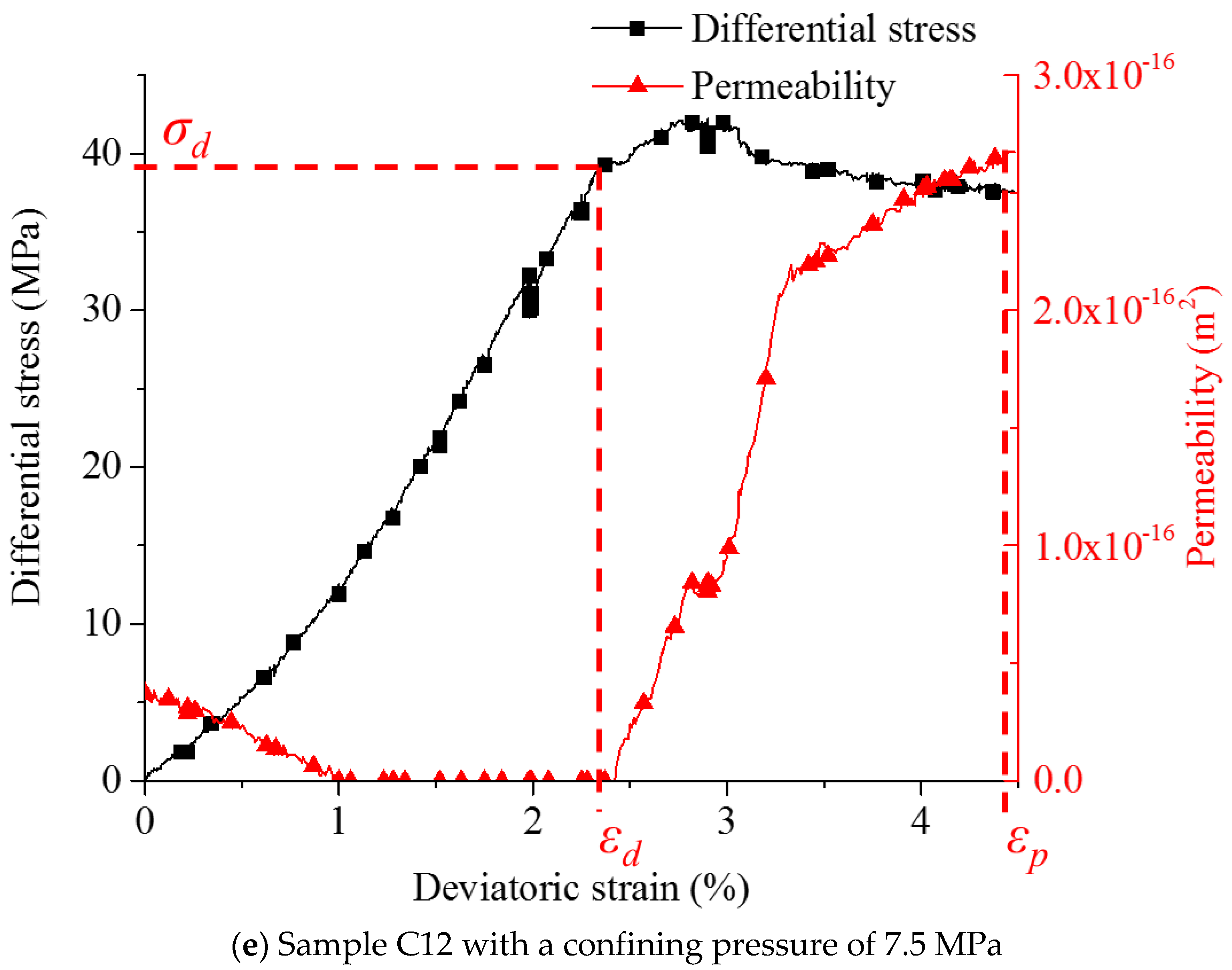

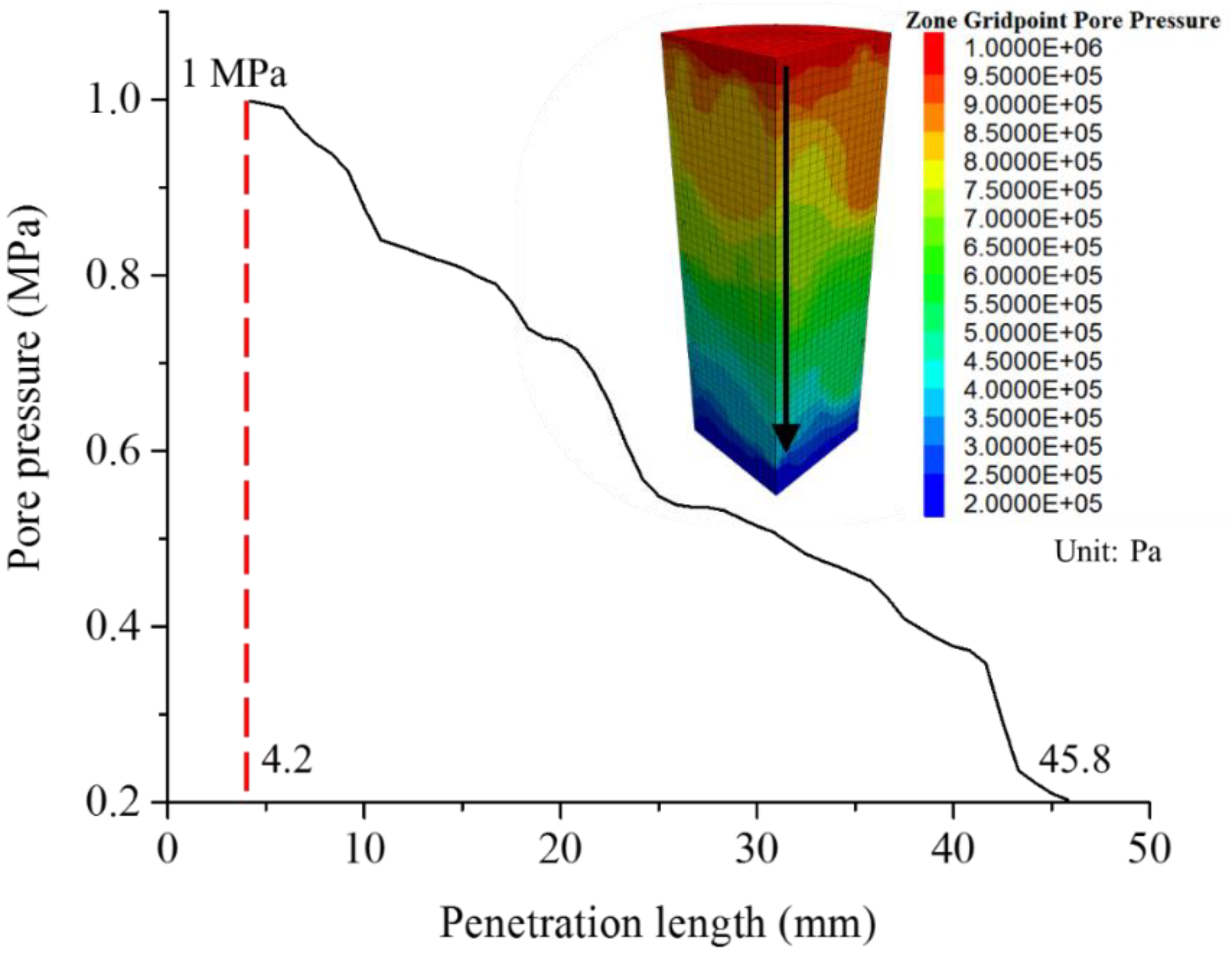
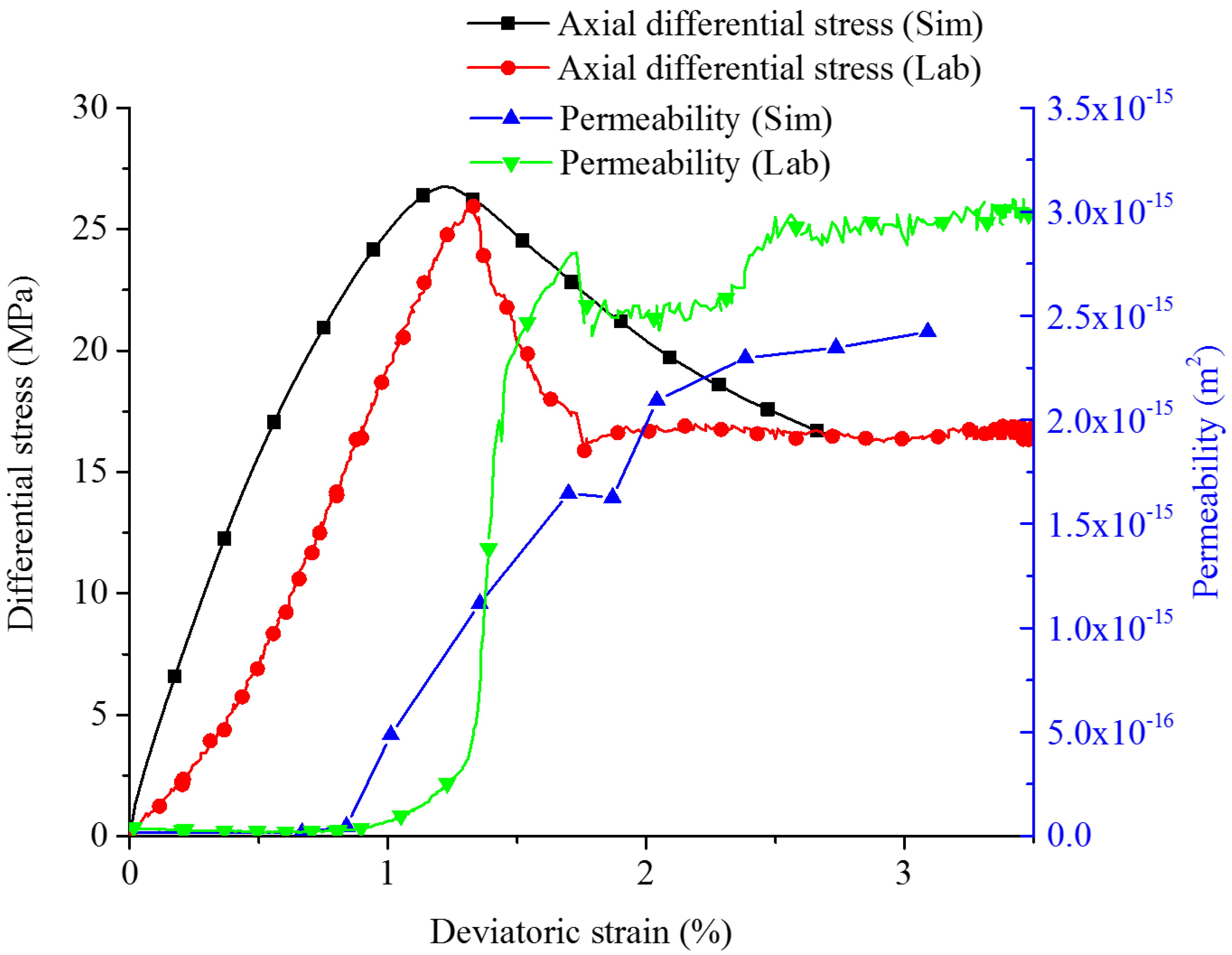
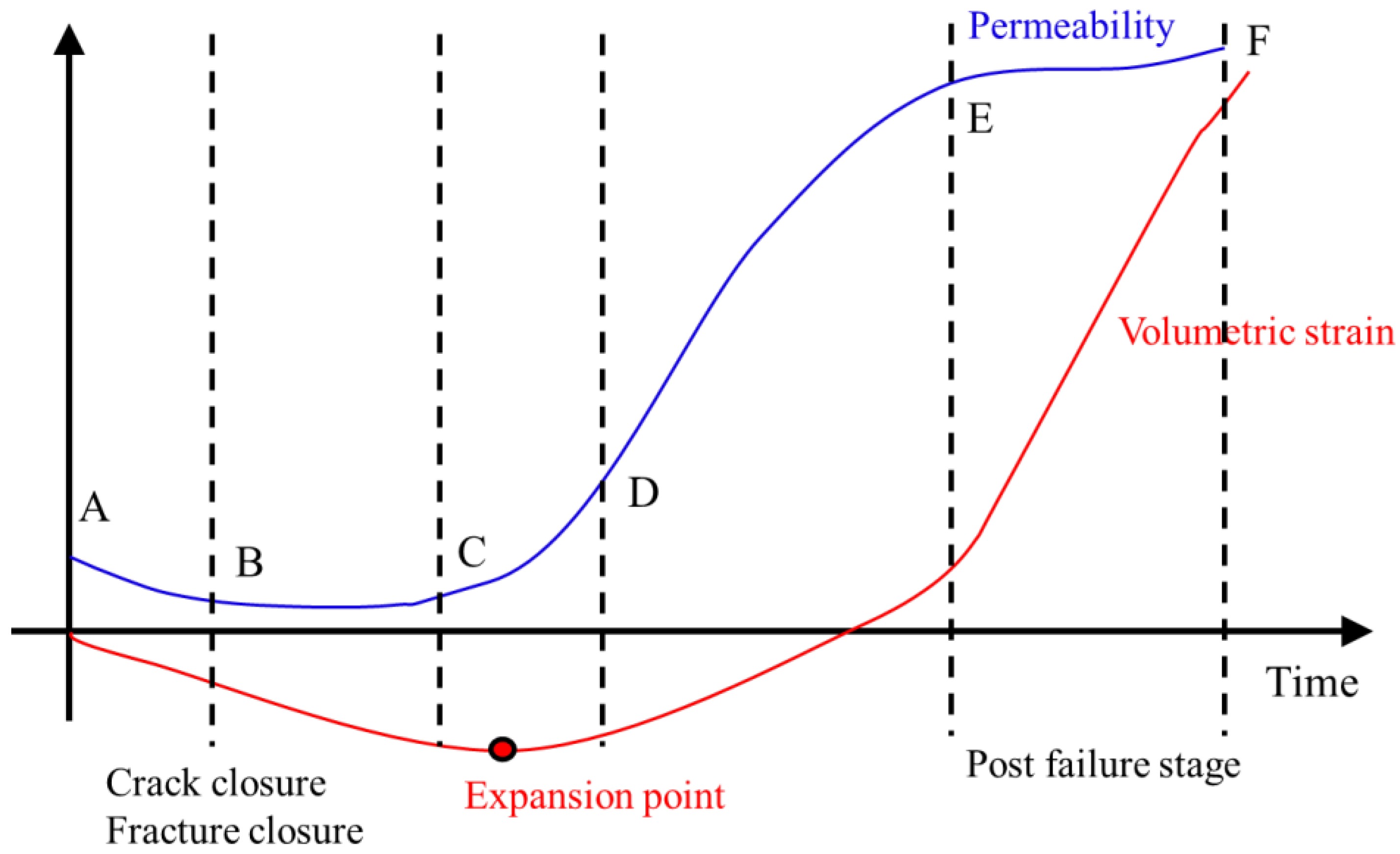
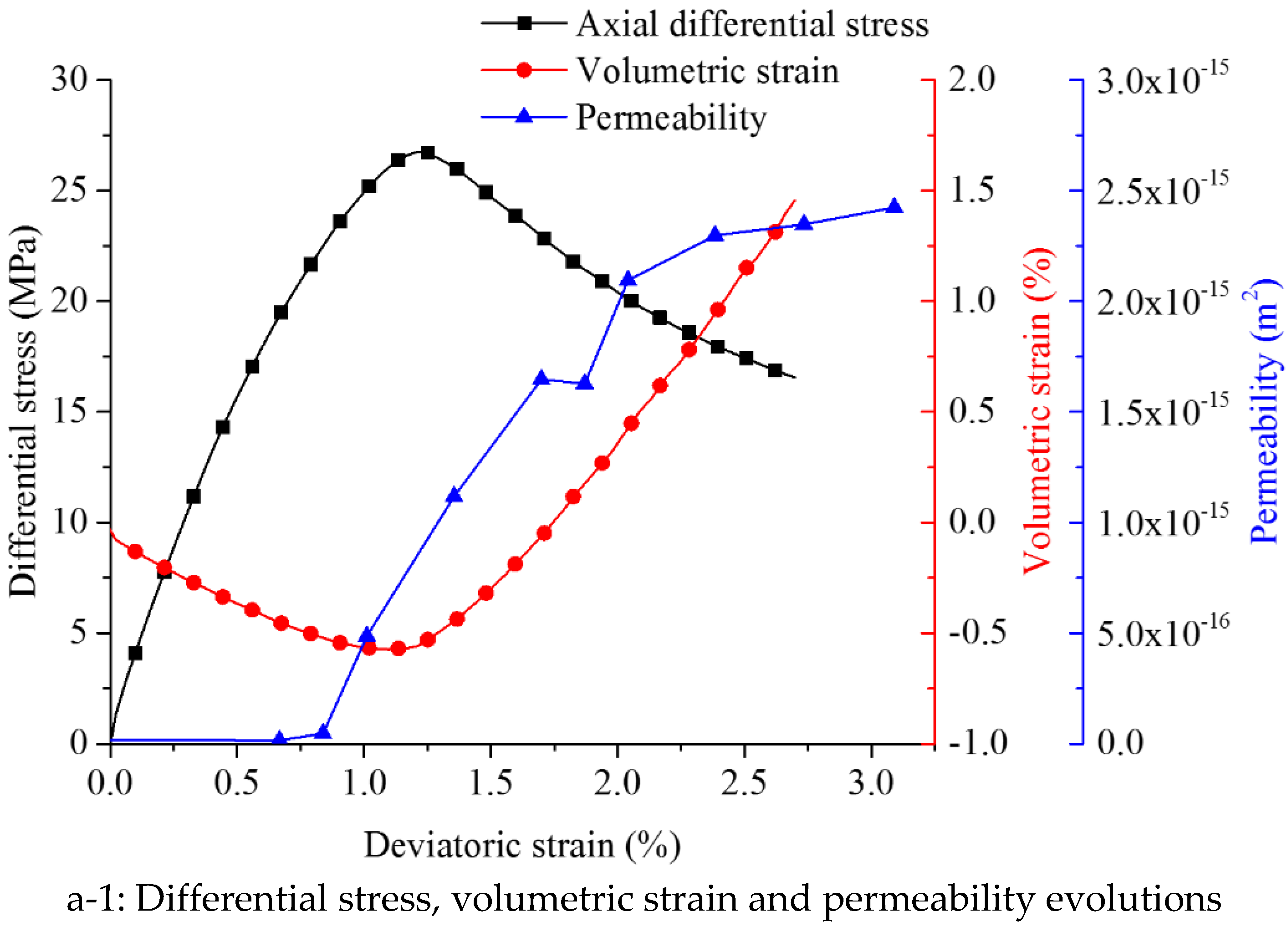
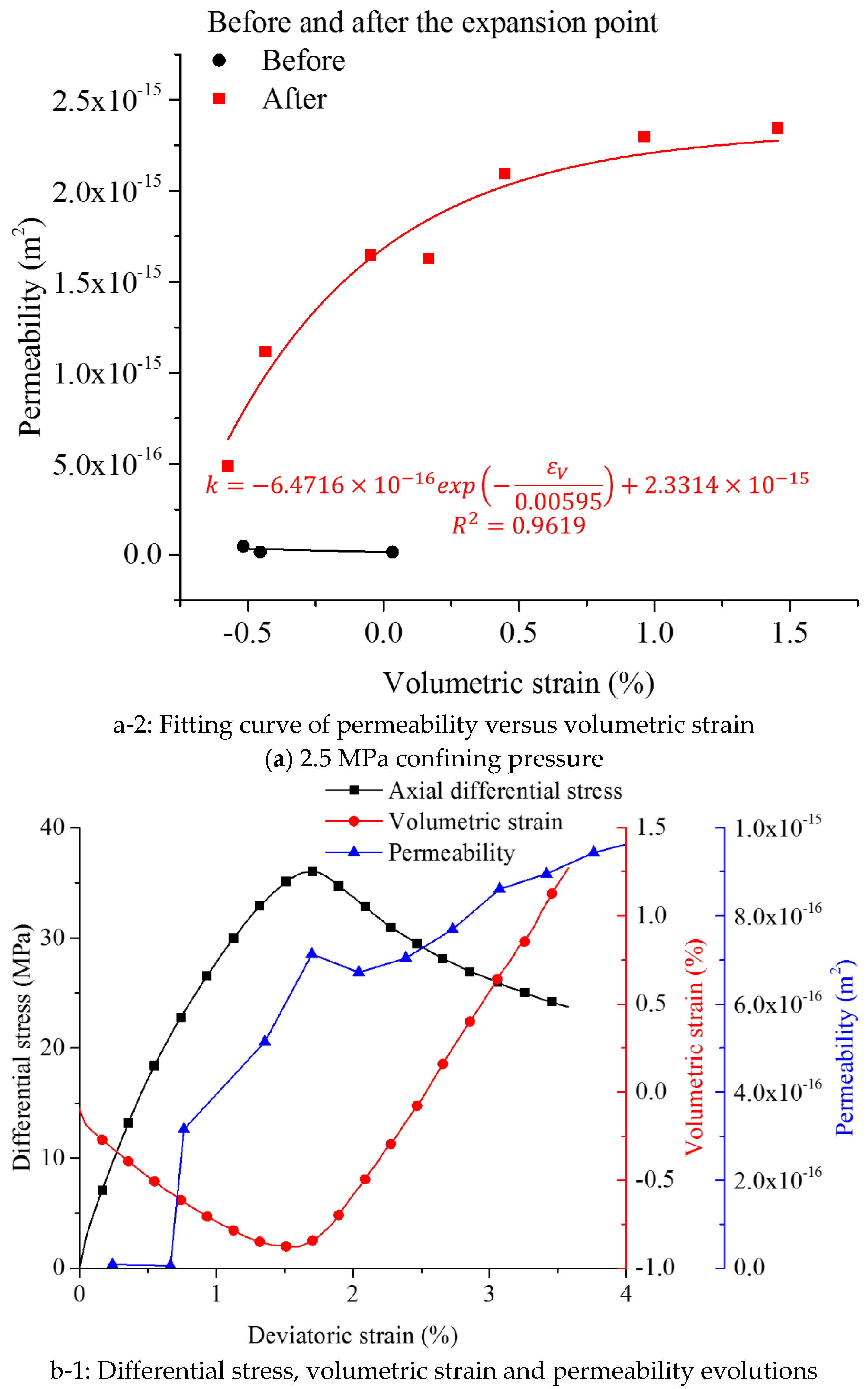
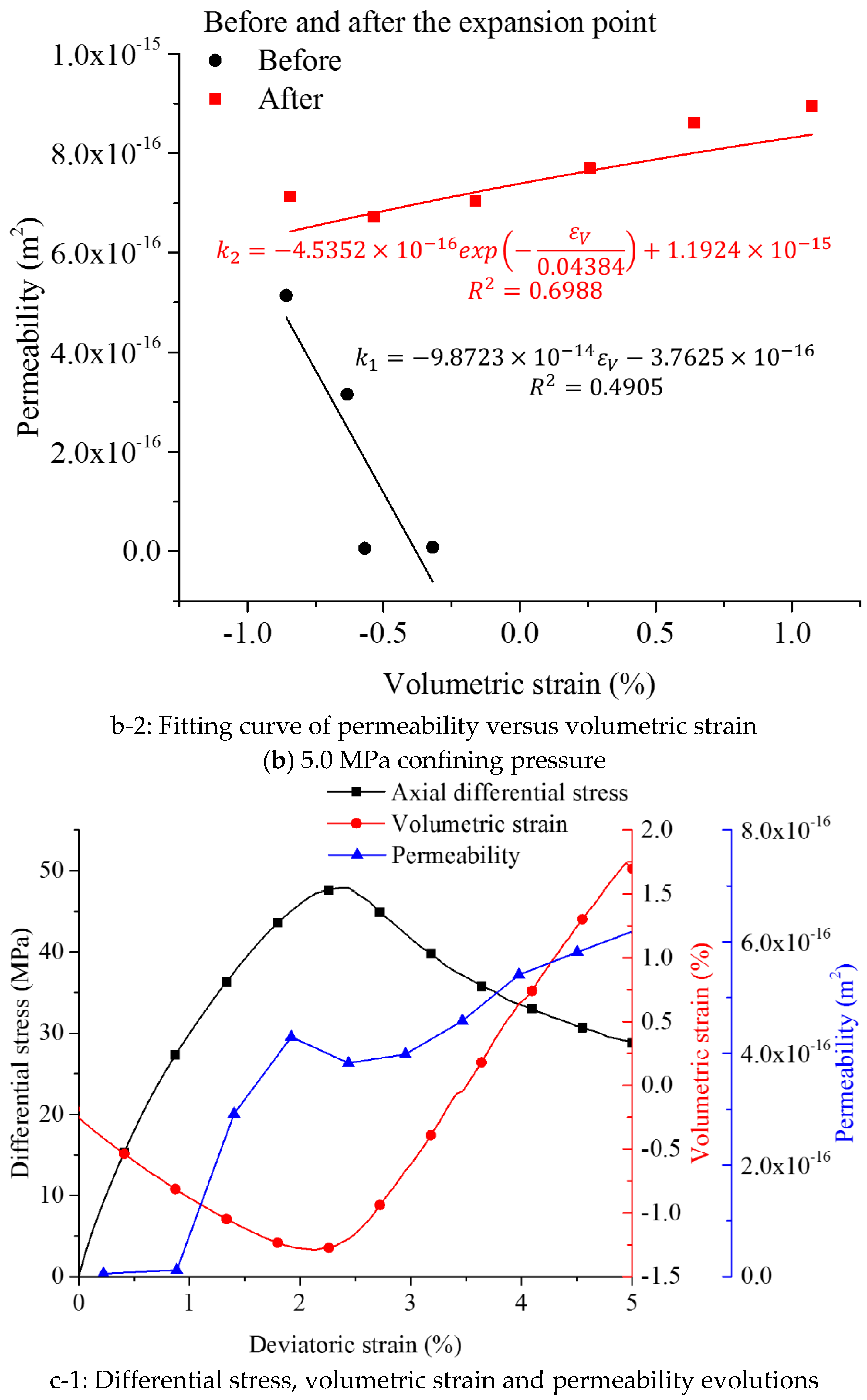
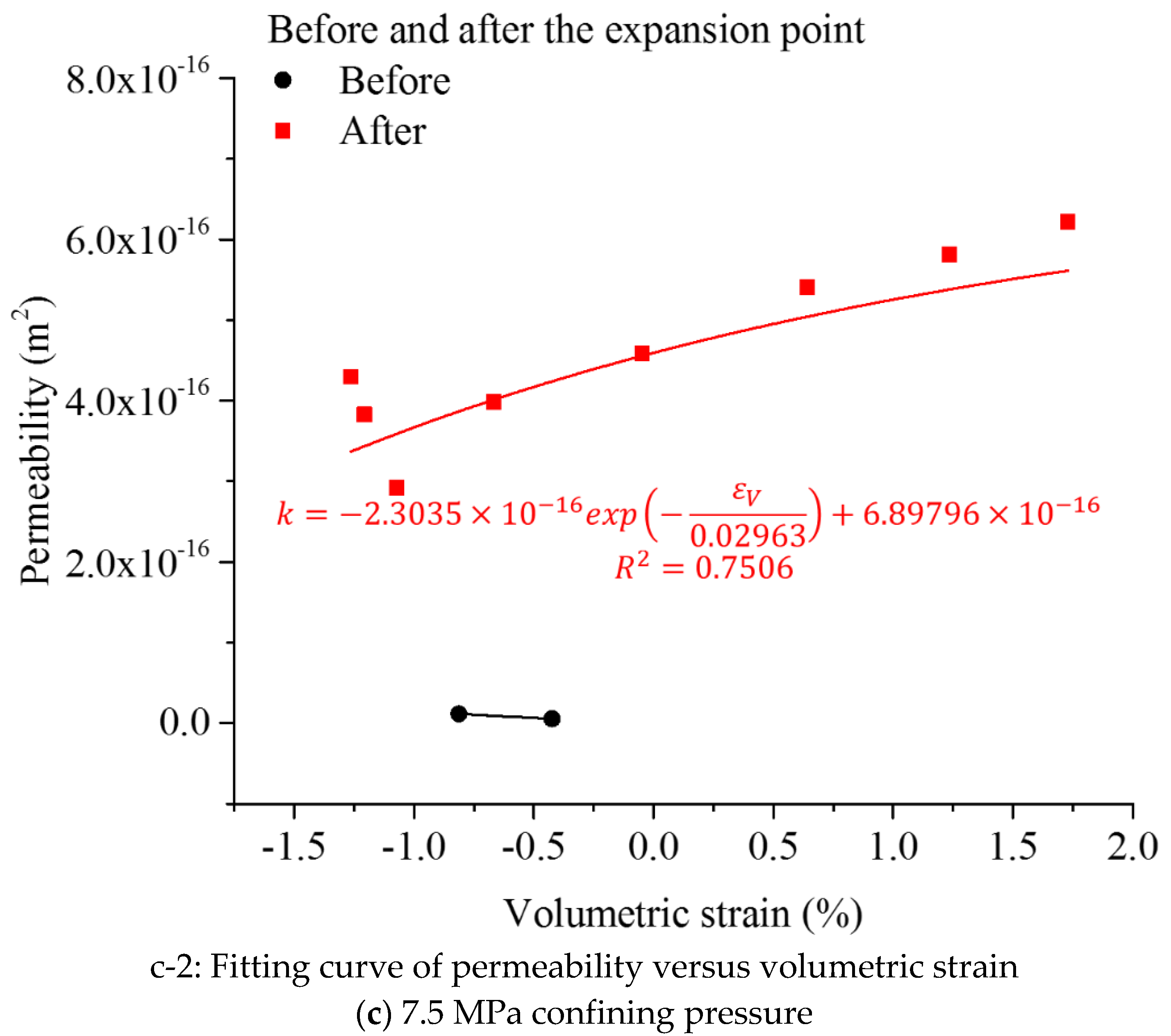

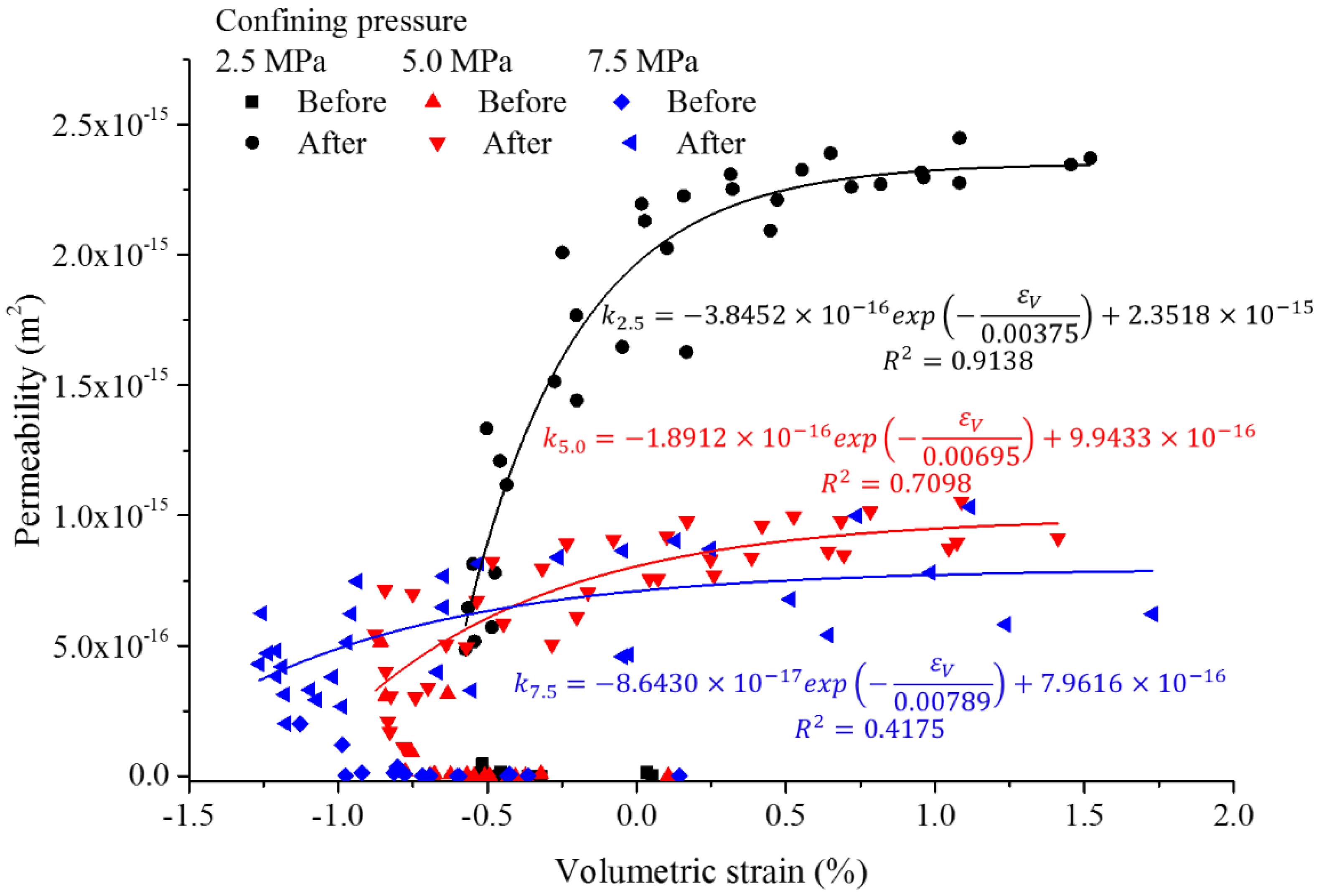
| Sample No. | Proportions | |
|---|---|---|
| Matrix | Inclusions | |
| C1 | 80.12% | 19.88% |
| C2 | 86.06% | 13.94% |
| C3 | 79.06% | 20.94% |
| C4 | 89.90% | 10.10% |
| C5 | 90.20% | 9.80% |
| Element | Parameter | Coal Matrix | Mineral Inclusion | Boundary between Matrix and Inclusion |
|---|---|---|---|---|
| Particles | N | 27,390 | 7218 | -- |
| rp (mm) | 0.5 | 0.5 | -- | |
| ρp (kg/m3) | 1390 | 1810 | -- | |
| Contacts | 1 | 1 | 1 | |
| E (GPa) | 2.09 | 2.84 | 1.90 | |
| K* | 14.65 | 2.44 | 1 | |
| t (MPa) | 17.40 | 30.50 | 11.60 | |
| (MPa) | 4.35 | 12.20 | 5.8 | |
| μc | 0.4 | 0.4 | 0.4 | |
| Φ (°) | 4 | 7 | 8 | |
| gc (mm) | 0.05 | 0.05 | 0.05 | |
| Axial loading control | ||||
| Walls | V (m/s) | 0.005 | ||
| Confinement control | ||||
| Walls | Vmax (m/s) | 0.01 | ||
| Parameters | Matrix | Inclusions |
|---|---|---|
| ρ (kg/m3) | 1500 | 2000 |
| E (GPa) | 1.5 | 3 |
| σt (Pa) | 5 × 105 | 5 × 105 |
| C (Pa) | 2.7 × 106 | 7.8 × 106 |
| ψ (°) | 10 | 5 |
| θ (°) | 50 | 35 |
| ν | 0.35 | 0.35 |
| ka (m2) | 1 × 10−18 | 5 × 10−16 |
| K (m/s) | 8.75 × 10−14 | 4.38 × 10−11 |
| φ (%) | 6 | 9 |
| Sample No. | Confinement σ3 (MPa) | Dimensions | Peak Permeability kP (m2) | |
|---|---|---|---|---|
| Diameter (mm) | Height (mm) | |||
| C1 | 2.5 | 25.50 | 50.60 | 2.8 × 10−15 |
| C11 | 2.5 | 24.77 | 49.80 | 2.43 × 10−15 |
| C13 | 5.0 | 24.99 | 50.02 | 8.85 × 10−16 |
| C4 | 7.5 | 25.47 | 50.85 | 6.55 × 10−16 |
| C12 | 7.5 | 24.89 | 49.89 | 2.67 × 10−16 |
| σ3 (MPa) | A (×10−16) | B (×10−16) | C | R2 |
|---|---|---|---|---|
| 2.5 | −3.8452 | 23.5180 | −0.00375 | 0.9138 |
| 5.0 | −1.8912 | 9.9433 | −0.00695 | 0.7098 |
| 7.5 | −0.8643 | 7.9616 | −0.00789 | 0.4175 |
Publisher’s Note: MDPI stays neutral with regard to jurisdictional claims in published maps and institutional affiliations. |
© 2022 by the authors. Licensee MDPI, Basel, Switzerland. This article is an open access article distributed under the terms and conditions of the Creative Commons Attribution (CC BY) license (https://creativecommons.org/licenses/by/4.0/).
Share and Cite
Zhao, Y.; Konietzky, H.; Frühwirt, T.; Zhou, H.W. Gas Permeability Evolution of Coal with Inclusions under Triaxial Compression-Lab Testing and Numerical Simulations. Materials 2022, 15, 8567. https://doi.org/10.3390/ma15238567
Zhao Y, Konietzky H, Frühwirt T, Zhou HW. Gas Permeability Evolution of Coal with Inclusions under Triaxial Compression-Lab Testing and Numerical Simulations. Materials. 2022; 15(23):8567. https://doi.org/10.3390/ma15238567
Chicago/Turabian StyleZhao, Yufeng, Heinz Konietzky, Thomas Frühwirt, and H.W. Zhou. 2022. "Gas Permeability Evolution of Coal with Inclusions under Triaxial Compression-Lab Testing and Numerical Simulations" Materials 15, no. 23: 8567. https://doi.org/10.3390/ma15238567
APA StyleZhao, Y., Konietzky, H., Frühwirt, T., & Zhou, H. W. (2022). Gas Permeability Evolution of Coal with Inclusions under Triaxial Compression-Lab Testing and Numerical Simulations. Materials, 15(23), 8567. https://doi.org/10.3390/ma15238567







